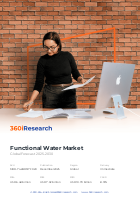
Functional Water Market by Ingredient Type (Amino Acids, Antioxidants, Botanicals), Product (Flavored Functional Water, Unflavored Functional Water), Packaging Type, Format, Pack Size, Use Case, Distribution Channel, End User, Age Group - Global Forecast 2025-2030
SKU
MRR-742BD517F020
Region
Global
Publication Date
December 2025
Delivery
Immediate
2024
USD 6.48 billion
2025
USD 7.02 billion
2030
USD 10.70 billion
CAGR
8.72%

Download a Free PDF
Get a sneak peek into the valuable insights and in-depth analysis featured in our comprehensive functional water market report. Download now to stay ahead in the industry! Need more tailored information? Ketan is here to help you find exactly what you need.



